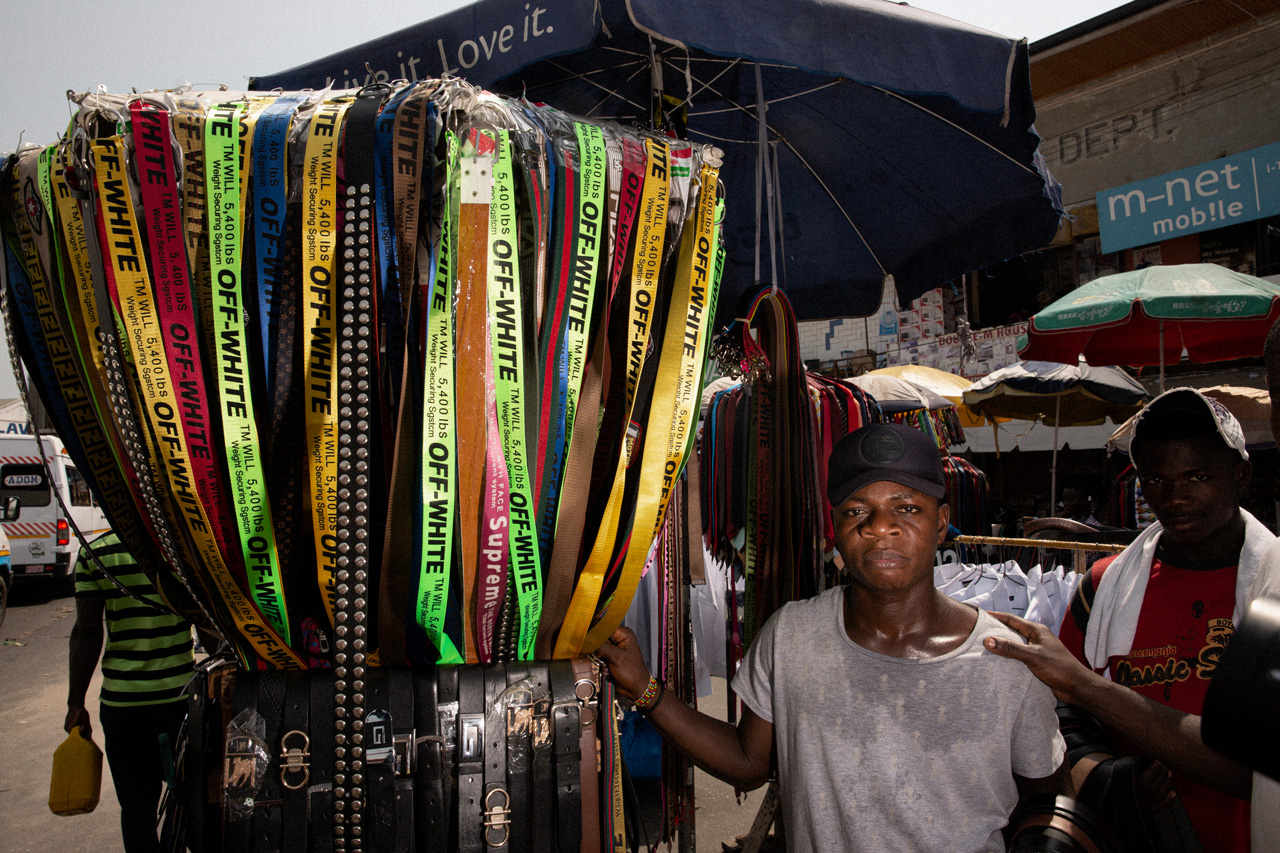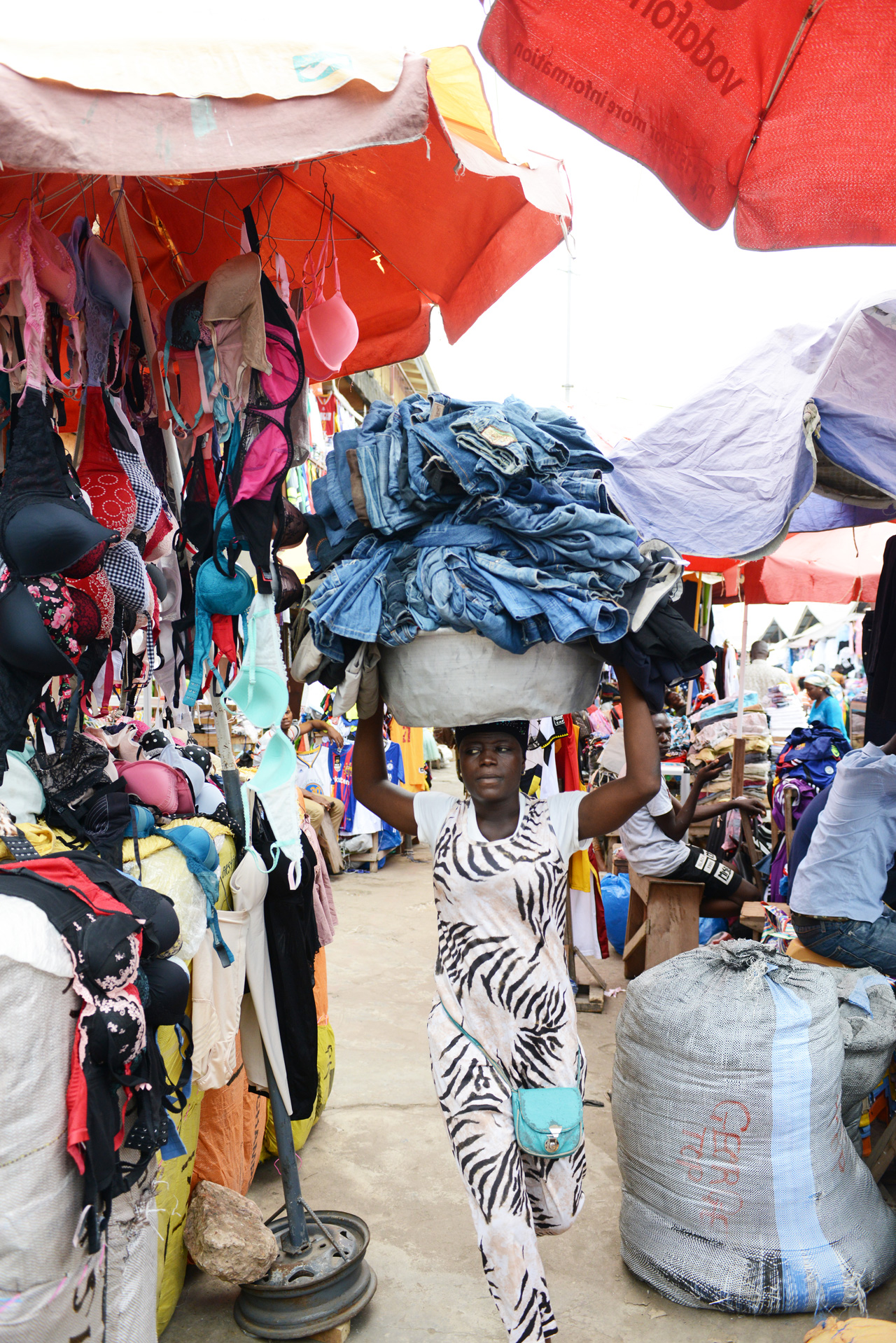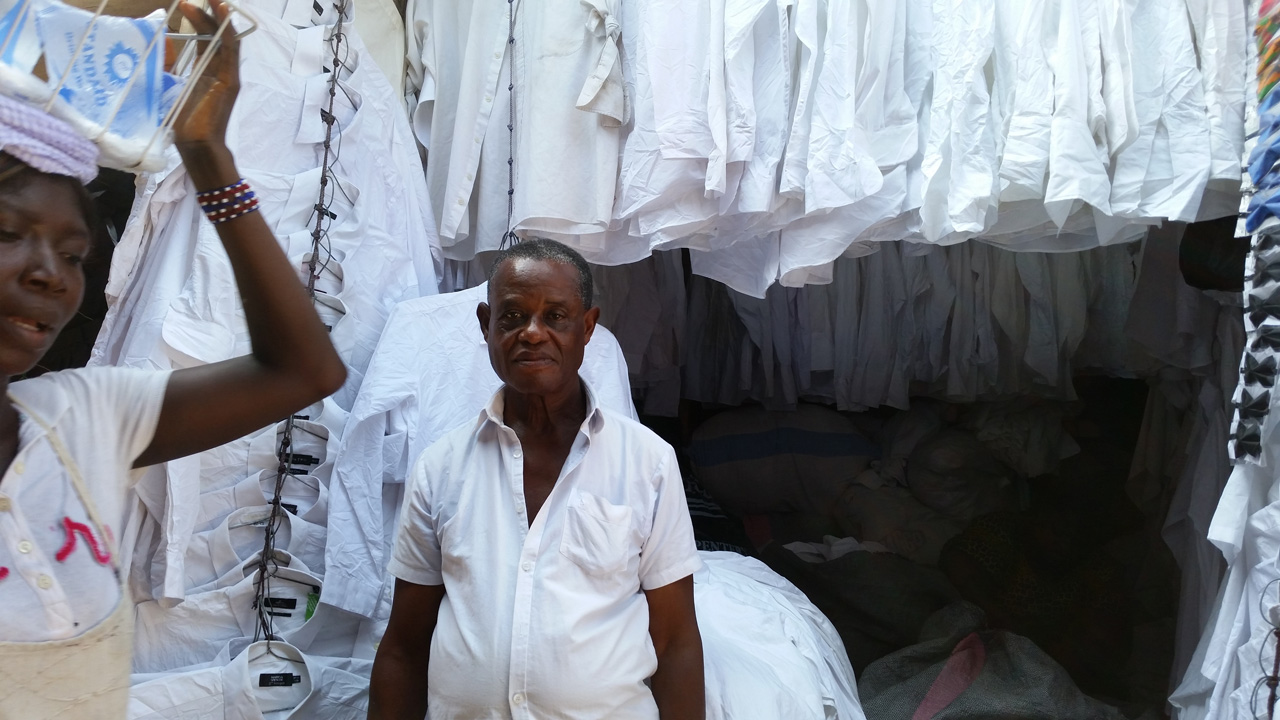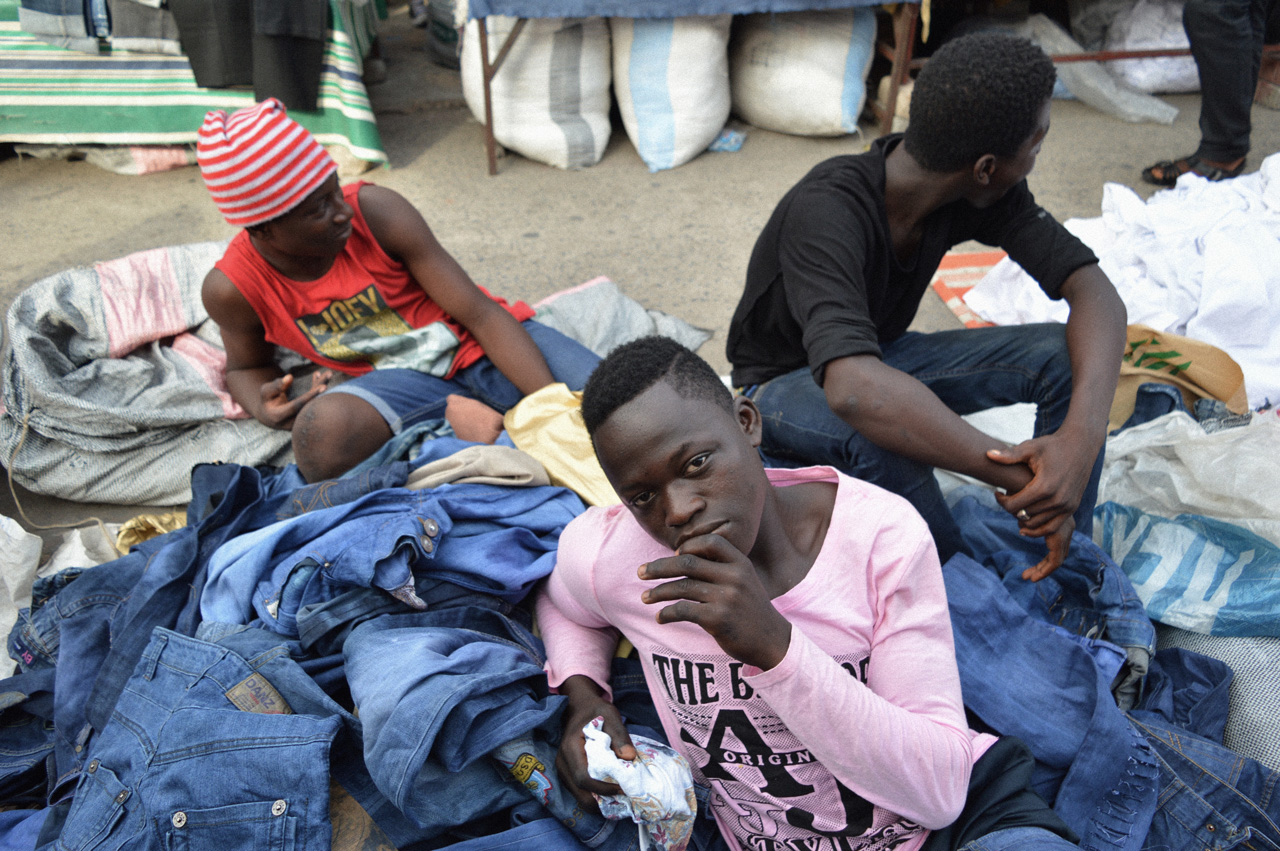Everything

The Gulf of Guinea is a stark paradox. To visitors, the west coastline of Africa is an idyllic paradise; sweeping stretches of sand and glistening blue waters. But, unbeknown to most, the shores of Ghana harbour a trade; one that reveals society’s deep obsession with toxic consumerism.
Kantamanto Market – in the city of Accra – is the epicentre of the second-hand clothing trade. The market’s biggest suppliers include America, the United Kingdom and Australia. Our donated clothing – as well as dead stock from retail giants – is causing Ghana to become a literal dumping ground. Clothing frequently finds itself in the ocean, only to resurface when the tide washes it upon the sand often with a final destination of burning landfill polluting the atmosphere.
By day, internet-savvy teenagers troll the twisting labyrinth of makeshift stalls, searching for coveted pieces to resell on Instagram and Facebook. Tourists cautiously weave through the market’s nooks for a glimpse into the publicised spectacle. It seems harmless but to locals, it’s referred to as “Obroni Wawu” – the Akan phrase – or in English, “the clothing of a dead white man”.
Since 2016, American-born Liz Ricketts – a former stylist and teacher – and her partner Branson Skinner have visited Kantamanto Market several times. As co-founders of the US-based not-for-profit organisation, OR Foundation, they work towards abolishing modern day slavery through education. Each visit, the duo collects data and collaborates with local government officials, market traders, consumers, designers, artists and retailers to expand their initiative known as Dead White Man’s Clothes. The aim is to not only present the city’s history to the rest of the world, but to empower the people of Ghana for a progressive future.
ICON sits down with Ricketts for insight into the growing trade and why we should reconsider our relationship with consumerism.

ICON: Your research pinpoints the earliest reference of the second-hand clothing trade to the 1960s. How did this start as an industry?
Ricketts: It was more about the relationship in terms of Ghana gaining its independence and a new market that opened up. It certainly was the beginning of a time period where people in the United States were extending credits to buy more clothing and shopping through catalogues. It was about moving away from having things made locally to consuming things at a faster pace. But nothing like what has happened in the last 20 years.
ICON: How does clothing find its way to Ghana?
Ricketts: Some of the clothing is donated but some of it is also what Ghanaian’s call “store rejects”. It’s stuff that didn’t sell during a sale, for instance, or things that have flaws. There are two different avenues and it depends on where you live. If you live somewhere more remote and you are donating clothing to a centre or a charity, that’s probably going to be transferred to a larger city. Usually 10 to 15 percent of the clothing can be sold locally and then the rest of it is going to be graded for export. Some of it will be graded for export to Poland, South America, South Africa – part of that is climate consideration. From there the clothing will be baled up according to the type of item it is. A lot of the clothing from the United States will be sent to Canada to be baled or to China. There is not one process that clothing takes, but eventually it is going to be exported and it arrives at the port of Tema [in Ghana].
ICON: How do the Ghanaian locals perceive the Western world?
Ricketts: There is always a spectrum with perspective. Generally speaking, it’s quite positive. I think it differs, however, for people who are experiencing our culture solely through the internet and those people who have actually travelled. Our research has found that Ghanaians who have had the opportunity to travel abroad and have experienced malls and fast fashion consumption certainly have a different understanding about where clothing is coming from.
ICON: How does the trade work in Ghana?
Ricketts: There are around 5,000 stalls and each of them is run by an individual retailer or sometimes a family. They typically buy one bale [of clothing] every single week from an importer. Once the retailer buys the bale, they really have no idea what the quality of the clothing is inside. They will open the package and start sorting the quality of the product in a process referred to as “selections”. There are four selections. The first selection is the best and often that is brands that people really gravitate towards or things that look like they have never been worn or a style that is really ‘in’ at that moment. Second and third selections make up the majority of every bale and those are things that look quite worn but are still wearable. The fourth selection are things that are already trashed.
ICON: Who are the customers of the Kantamanto Market?
Ricketts: It is mostly locals. Certainly, people who visit Ghana are fashion and thrift enthusiasts and they hear about [the market] and they go to check it out. But it is overwhelmingly locals across different genders, classes, ages and professions.
ICON: The OR Foundation works to eradicate slavery. Where does this come into the trade?
Ricketts: Throughout the whole process, there are women and young girls called “kayayo” which means “head porter”. They are migrants from the northern region of Ghana. Some girls are trafficked but the majority are seeking a better life and to make money to send back to their family or to put themselves through school. They are performing back-breaking labour and are transporting bales for up to two miles [or 3.2 kilometres] around the market. The bales weigh around 120 to 200 pounds [54 – 90 kilograms] each and they are doing that on their heads. It’s very, very dangerous and they are also paid very little, between USD $0.30 cents and USD $1 [AUD $0.46 – AUD $1.50] per trip.

ICON: Is there competition amongst customers for the best product?
Ricketts: Typically, consumers are people who own their own boutiques or are sellers on Instagram or Facebook. They arrive really early at the market to secure the best stuff from the first selection. The rest of the clothing is sold or becomes material for remaking and upcycling. Stylists and designers also come to the market and buy-up on the lower-grade things and have them tailored or dyed.
ICON: Who is profiting the most from this practice?
Ricketts: Definitely the importers but their bottom line has been impacted by fast fashion as well. Even though importers can generally pass off the burden of the waste onto the retailer, retailers have no idea what they’re buying. A lot of the importers are quite nervous to talk about [the work]. We have a relationship with several importers but even with building a lot of trust, they don’t want to be on camera or to be documented in any way. They feel a lot of pressure from the exporters in the global North to take the waste. They receive a packing list and it might have 10 bales of winter coats. Ghana is on the equator, you don’t need that many winter coats. They say if they were to tell the exporters that they don’t want these bales, that would ruin their relationship, so they have to take the containers even with the waste.
ICON: Do Ghanaians view clothing waste as an issue?
Ricketts: Yes, some do. There are people who are aware because they have proximity to the issue – like myself. I started this research because I worked in the fashion industry so I could see it. It’s the same in Ghana. When you talk to people in the market, you talk to people who work in waste management and they’re very aware. Or you talk to the people who live near the informal dumps or you talk to the people who live on the water and they see the clothing washing up on the beaches, obviously those people know. But I don’t think there is more awareness in the general public in Ghana than there is anywhere else in the world. A lot of the work that we do is trying to bring more transparency to everyone.
ICON: What percentage of these clothes are becoming waste?
Ricketts: Our research shows that a minimum of 40 percent of the clothing becomes waste. That’s between four to six million items of clothing a week.
ICON: Your work focusses solely on Ghana. Why not expand this research to other parts of Africa?
Ricketts: For one, we have a relationship with Ghana. We’ve been working there for a decade. Two, I think that research can be quite extractive. We’re white Americans going to Ghana to do this work and there is always going to be a dynamic where we’re not going to be the best people to do this. There is always going to be limitations. Instead of moving around regions and trying to accumulate some sort of clout by doing this work, we would rather stay committed to this particular community and really focus. We tell ourselves, ‘Ok, we’re doing this research on these specific points of tension, how can we respond to them and how can we do that in an inclusive way? How can we make sure that our information is empowering people in Ghana and isn’t just about us presenting their story to the outside world?’
ICON: Even if clothing is being given a second chance in overseas markets, should it be considered a viable option for recycling?
Ricketts: Reuse is positive and a lot of people in Ghana still view the second-hand clothing industry very positively. There is a level of need in terms of access to clothing that is cheaper, but I have never considered it recycling. I think that language is really quite misleading for consumers. If a brand says they’re recycling the clothing that you’re donating for instance, what that conjures in people’s minds is that they’re turning that into new clothing, and that’s not true. It’s quite problematic and I think brands should be held accountable for their language.
ICON: Aside from consuming less, how can we contribute to finding a solution to this growing problem?
Ricketts: Instead of trying to change your relationship with consumption, start pressuring brands who are ultimately responsible for over-producing. As a consumer, think, ‘What can I start demanding from the brands that I shop from? What can I start advocating for in terms of policies that would stop that?’ Support non-profits and companies that are working towards solutions for making use of their waste. Largely the issue is people thinking that donating clothing is a one-way street. Thinking of it as charity or as a service to somebody who you assume has less than you. The more we can recognise it as waste-management and not charity, the more we can have a real conversation about what’s next.
For more information on Dead White Man’s Clothes, visit deadwhitemansclothes.org

